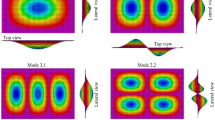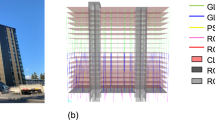Abstract
In semi-urban setting where availability of land can afford construction of low-rise buildings, confined masonry may compete with other alternatives of seismic resilient system provided well-articulated design standards and construction guidelines are available. Most seismic standards do not make explicit recommendations on the natural period and vertical distribution of base shear for the design of confined masonry buildings. In such a case, one of the two alternatives, such as (1) reinforced concrete (RC) frame building with masonry infill walls and (2) RC frame building with structural walls, is tacitly extrapolated. This paper is first aimed to explore the possible recommendations from the ambient vibration testing of a class of confined masonry building stock. Nine (G + 3) confined masonry hostel buildings are considered for Ambient Vibration Testing (AVT). Recorded signatures are processed and modal characteristics (primarily restricted to the first triplet of fundamental modes) are extracted. Each building is modelled numerically and fine-tuned followed by a comparison of natural frequencies and mode shapes in numerical model and experimental results. The fine-tuned numerical models are analysed against a set of recorded ground motions. Possible design recommendations for natural period and distribution of base shear along the height are the key contributions. Empirical equation for natural periods is derived from the seismic code recommendation on that of reinforced concrete (RC) buildings but removing the bias contributed from the height shorter than one storey while using the experimental results. Distribution of the base shear along the height follows a parabolic profile with an exponent close to 0.4. Results of AVT indicate the inherent damping ratio on an average of about 5% which, however, may not be directly used for seismic excitation. The building stock used for AVT in this paper does not include considerable variations in height and different varieties of confined masonry constructions. Therefore, recommendations of this paper should be verified against a larger size of dispersed building stock.




Adapted from Nema and Basu (2019)

















Similar content being viewed by others
Availability of data and material
Data may be available from the corresponding author through making reasonable request.
Code availability
Standard licenced software is used. Custom code is developed in MATLAB environment and not available for sharing.
References
ASCE/SEI 7-16 (2017) Minimum design loads for buildings and other structures, Standard ASCE/SEI7-16. American Society of Civil Engineers
Astroza M, Moroni O, Brzev S, Tanner J (2012) Seismic performance of engineered masonry buildings in the 2010 Maule earthquake. Earthq Spectra 28(S1):S385–S406
Au S-K, Zhang F-L (2012) Ambient modal identification of a primary–secondary structure by Fast Bayesian FFT method. Mech Syst Signal Process 28:280–296
Basu D (2019) Back-of-the-Envelope analysis of plan-asymmetric confined masonry buildings for force-based seismic design. J Build Eng 21:455–467
Basu D, Whittaker AS, Constantinou MC (2017) On the design of a dense array to extract rotational components of earthquake ground motion. Bull Earthq Eng 15(3):827–860
Bashir A, Basu D (2018) Revisiting probabilistic seismic hazard analysis of gujarat: an assessment of indian design spectra. Nat Hazards 91(3):1127–1164
Bendat JS, Piersol AG (2011) Random data: analysis and measurement procedures, vol 729. Wiley, Hoboken
Brincker R, Andersen P, Jacobsen N-J (2007) Automated frequency domain decomposition for operational modal analysis. In: Proceedings of The 25th international modal analysis conference (IMAC), Orlando, Florida. vol 415
Brincker R, Ventura C (2015) Introduction to operational modal analysis. Wiley, Hoboken
Brincker R, Zhang L, Andersen P (2000) Modal identification from ambient responses using frequency domain decomposition. In: Proceedings of the 18th international modal analysis conference (IMAC), San Antonio, Texas
Brincker R, Zhang L, Andersen P (2001) Modal identification of output-only systems using frequency domain decomposition. Smart Mater Struct 10(3):441
Brownjohn JMW, Magalhaes F, Caetano E, Cunha A (2010) Ambient vibration re-testing and operational modal analysis of the Humber Bridge. Eng Struct 32(8):2003–2018
Chakra-Varthy P (2019) Confined masonry buildings: evaluation of modal properties using ambient vibration testing. MTech Thesis, Indian Institute of Technology Gandhinagar
Conte JP, He X, Moaveni B, Masri SF, Caffrey JP, Wahbeh M, Tasbihgoo F, Whang DH, Elgamal A (2008) Dynamic testing of Alfred Zampa memorial bridge. J Struct Eng ASCE 134(6):1006–1015
De Sortis A, Antonacci E, Vestroni F (2005) Dynamic identification of a masonry building using forced vibration tests. Eng Struct 27(2):155–165
Eurocode-8 (2009) Design of structures for earthquake resistance: part 1: general rules, seismic actions and rules for buildings. In: European Committee for Standardization, B-1050, Brussels
Felber AJ (1994) Development of a hybrid bridge evaluation system. PhD thesis. University of British Columbia
Foraboschi P (2019) Masonry does not limit itself to only one structural material: Interlocked masonry versus cohesive masonry. J Build Eng 100831
Foraboschi P (2016) The central role played by structural design in enabling the construction of buildings that advanced and revolutionized architecture. Constr Build Mater 114:956–976
Goel RK, Chopra AK (1997) Vibration properties of buildings determined from recorded earthquake motions. Report No. UCB/EERC-97/14, Earthquake Engineering Research Center, University of California
Goulet J-A, Michel C, Smith IFC (2013) Hybrid probabilities and error-domain structural identification using ambient vibration monitoring. Mech Syst Signal Process 37(1–2):199–212
Heylen W, Lammens S, Sas P (1995) Modal analysis theory and testing, Department of Mechanical Engineering, Katholieke Universiteit Leuven, Leuven, Belgium
Humar JL (2012) Dynamics of structures. CRC Press, Boca Raton
IS 1893-Part 1 (2016) Criteria for earthquake resistant design of structures Part-1: General Provisions and Buildings, Bureau of Indian Standards, Manak Bhavan, New Delhi
IS 456 (2000) Plain and Reinforced Concrete—Code of Practice, Bureau of Indian Standards, Manak Bhavan, New Delhi
Jacobsen N-J (2006) Separating structural modes and harmonic components in operational modal analysis. In: Proceedings IMAC XXIV conference
Liu Y-C, Loh C-H, Ni Y-Q (2013) Stochastic subspace identification for output-only modal analysis: application to super high-rise tower under abnormal loading condition. Earthq Eng Struct Dynam 42(4):477–498
Magalhaes F, Caetano E, Cunha A, Flamand O, Grillaud G (2012) Am-bient and free vibration tests of the Millau Viaduct: evaluation of alternative processing strategies. Eng Struct 45:372–384
Meli R, Brzev S, Astroza M, Boen T, Crisafulli F, Dai J, Farsi M, Hart T, Mebarki A, Moghadam AS et al. (2011) Seismic design guide for low-rise confined masonry buildings, Oakland, California 94612-1934, Earthquake Engineering Research Institute
NBCC (2015) National building code of Canada. In: National Research Council and others, Ottawa, Canada
Nema H, Basu D (2019) Natural properties of confined masonry buildings–experimental case studies and possible inferences. Int J Masonry Res Innov 4(3):197–226
NZS 1170-5 (2004) Structural Design Actions, Part 5: Earthquake Actions—New Zealand
Parloo E, Guillaume P, Cauberghe B (2003) Maximum likelihood identification of non-stationary operational data. J Sound Vib 268(5):971–991
Parloo E (2003) Application of frequency-domain system identification techniques in the field of operational modal analysis. Vrije Universiteit Brussel, Belgium
Peeters B, De Roeck G (1999) Reference-based stochastic subspace identification for output-only modal analysis. Mech Syst Signal Process 13(6):855–878
Peeters B, De Roeck G (2001) Stochastic system identification for operational modal analysis: a review. J Dyn Syst Meas Contr 123(4):659–667
Rainieri C, Fabbrocino G (2014) Operational modal analysis of civil engineering structures: An introduction and a guide for applications. Springer, New York
Reynders E, Magalhaes F, De Roeck G, Cunha A (2009) Merging strategies for multi-setup operational modal analysis: application to the Luiz I steel arch bridge. In: Proceedings of IMAC. vol 27
Rodda GK, Basu DB (2020) A novel framework for conditional simulation of fully nonstationary spatially varying ground motion field. Earthq Eng Struct Dyn. https://doi.org/10.1002/eqe.3343
Trifunac MD (1972) Comparisons between ambient and forced vibration experiments. Earthq Eng Struct Dyn 1(2):133–150
Turek M, Thibert K, Ventura C, Kuan S (2006) Ambient vibration testing of three unreinforced brick masonry buildings in Vancouver, Canada. In: Proceedings of the 24th International Modal Analysis Conference (IMAC), Saint Louis, MI, USA
UBC (1997) Uniform building code. In: International Conference of Building Officials, Whittier, CA
Valente M, Milani G (2019) Damage assessment and collapse investigation of three historical masonry palaces under seismic actions. Eng Fail Anal 98:10–37
Valente M, Milani G (2018) Damage assessment and partial failure mechanisms activation of historical masonry churches under seismic actions: three case studies in Mantua. Eng Fail Anal 92:495–519
Verma R, Basu D (2017) On correlating the modulus of elasticity of stack- bonded flyash brick masonry using impact hammer and compression tests. Eur J Civ Environ Eng. https://doi.org/10.1080/19648189.2017.1410232
Vestroni F, Beolchini GC, Antonacci E, Modena C (1996) Identification of dynamic characteristics of masonry buildings from forced vibration tests. In: Proceedings of the 11th world conference on earthquake engineering
Xie Y, Liu P, Cai G-P (2016) Modal parameter identification of flexible spacecraft using the covariance-driven stochastic subspace identification (SSI-COV) method. Acta Mech Sin 32(4):710–719
Zhang L, Brincker R (2005) An overview of operational modal analysis: major development and issues. In: 1st international operational modal analysis conference. Aalborg Universitet, pp 179–190
Acknowledgements
This research is funded by the Council of Scientific and Industrial Research, India, under the Grant No. 22/762/17/ EMR-II. Financial support is gratefully acknowledged. Authors also acknowledge Mr. Abhi Mittal for his assistance while testing some of the buildings and Mr. Falak Vats during preparation of the manuscript.
Funding
This research is funded by Council of Scientific and Industrial Research, India, under the Grant No. 22/762/17/ EMR-II and the financial support is acknowledged.
Author information
Authors and Affiliations
Contributions
DB proposed the idea, interpret the results, prepared the final draft, acquire the funding, interpreted results, and manage the overall research. PC performed the experiments, processed the data, analysed with custom code, and licenced software, generated results, and prepared the first draft.
Corresponding author
Ethics declarations
Conflict of interest
Authors declare that the manuscript is free from any Conflicts of interest and Competing interests.
Additional information
Publisher's Note
Springer Nature remains neutral with regard to jurisdictional claims in published maps and institutional affiliations.
Rights and permissions
About this article
Cite this article
Chakra-Varthy, P., Basu, D. Natural period and vertical distribution of base shear in confined masonry buildings using ambient vibration test. Bull Earthquake Eng 19, 1851–1899 (2021). https://doi.org/10.1007/s10518-021-01046-8
Received:
Accepted:
Published:
Issue Date:
DOI: https://doi.org/10.1007/s10518-021-01046-8




